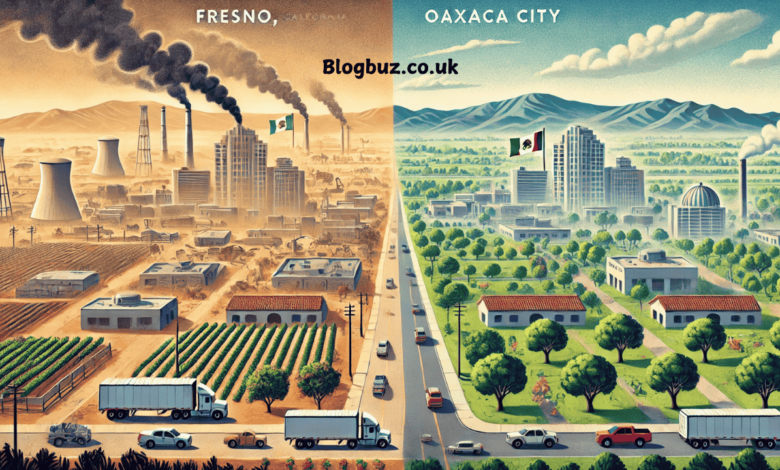Fresno vs Oaxaca City: A Comprehensive Comparison of Pollution Levels

When comparing cities like Fresno, California, and Oaxaca City, Mexico, one of the most critical aspects to consider is air quality and pollution levels. Both cities have unique environmental challenges and characteristics that shape their air quality. This article offers a comprehensive examination of the pollution levels in Fresno and Oaxaca City, exploring the factors that contribute to their environmental conditions and how they impact the health and lifestyle of their residents.
Overview of Fresno, California
Fresno, located in California’s San Joaquin Valley, is known for its agricultural productivity. However, the region’s geographical and industrial features significantly affect air quality. As per the 2022 State of the Air report by the American Lung Association, Fresno consistently ranks among the communities with the poorest air quality in the United States.
Key Pollution Indicators in Fresno:
- PM2.5 Levels: Particulate matter smaller than 2.5 micrometers is a severe concern. These minute particles can penetrate the airways and cause long-term health issues. Fresno often records PM2.5 levels exceeding national standards, especially during wildfire season.
- Ozone Pollution: Fresno ranks high for ozone pollution, often attributed to vehicular emissions and industrial activities. Ozone has the potential to exacerbate conditions and cause respiratory issues like asthma.
- Seasonal Variations: During summer and wildfire seasons, the air quality in Fresno worsens due to the combination of heat, stagnant air, and smoke from nearby fires. The Palisades Fire, for instance, has contributed significantly to air quality concerns in the region, as it has caused extensive smoke to drift into Fresno and surrounding areas, intensifying the health risks associated with poor air quality during wildfire season.
Contributing Factors to Fresno’s Pollution:
- Agricultural Operations: Fresno’s thriving agrarian industry generates significant dust and chemical emissions.
- Traffic and Industrial Emissions: High vehicle density and industrial activities contribute to nitrogen oxides and volatile organic compounds.
- Geographical Features: The valley’s bowl-like geography traps pollutants, creating a smog layer that’s hard to disperse.
Overview of Oaxaca City, Mexico
Oaxaca City, the capital of Oaxaca state, is renowned for its stunning natural grandeur and rich cultural heritage landscapes. While pollution levels are generally lower than in major urban centers in Mexico, the city faces environmental challenges.
Key Pollution Indicators in Oaxaca City:
- PM2.5 and PM10 Levels: Oaxaca City’s particulate matter levels are typically lower than Fresno’s. The city’s air quality often falls within the “Good” to “Moderate” categories on the Air Quality Index (AQI).
- Localized Pollution: Hotspots exist near markets and heavily trafficked areas, mainly due to vehicular emissions and open burning.
- Natural Conditions: Oaxaca’s topography and breezy climate help disperse pollutants, maintaining better air quality than Fresno.
Contributing Factors to Oaxaca’s Pollution:
- Traffic Emissions: Older vehicles and the lack of strict emissions regulations contribute to localized air pollution.
- Burning Practices: Agricultural and waste burning are occasional sources of air pollution.
- Industrial Activity: Limited industrial operations reduce overall emissions compared to cities like Fresno.
Fresno vs Oaxaca City: Air Quality Comparison
PM2.5 Levels:
- Fresno: Frequently records PM2.5 levels in the “Unhealthy” range, especially during wildfire seasons.
- Oaxaca City: Maintains lower PM2.5 levels, typically in the “Good” to “Moderate” range.
Ozone Pollution:
- Fresno: High levels due to industrial activities and vehicle emissions.
- Oaxaca City: Minimal ozone pollution due to fewer industrial emissions.
Seasonal Variations:
- Fresno: Wildfires, agricultural activities, and stagnant weather patterns cause significant seasonal spikes.
- Oaxaca City: Experiences occasional increases in pollution due to agricultural burning but maintains better overall air quality.
Health Implications:
- Fresno: High rates of asthma and respiratory illnesses are linked to poor air quality.
- Oaxaca City: Fewer air quality-related health issues due to relatively cleaner air.
How Pollution Impacts Daily Life
In Fresno:
- Residents often face “Spare the Air” alerts, urging them to limit outdoor activities during high-pollution days.
- Children and older people are particularly vulnerable to respiratory issues.
- Wildfire seasons bring additional challenges, with smoky conditions affecting visibility and air quality.
In Oaxaca City:
- Residents enjoy better outdoor living conditions most of the year.
- Pollution-related health warnings are rare, though traffic and burning practices can lead to localized problems.
Mitigation Efforts
Fresno:
- The city has implemented several measures to address air quality, including stricter emissions standards and initiatives to promote cleaner transportation options like electric vehicles.
- Agencies like the San Joaquin Valley Air Pollution Control District work on policies to reduce industrial emissions and manage agricultural pollution.
- Public awareness campaigns encourage residents to reduce activities contributing to poor air quality, such as burning wood in fireplaces.
Oaxaca City:
- Efforts are underway to improve vehicle emissions standards and promote alternative transportation methods like cycling.
- Public education campaigns focus on reducing open burning and improving waste management practices.
- Local government initiatives aim to preserve green spaces and reduce deforestation.
Conclusion
The comparison between Fresno and Oaxaca City highlights stark differences in pollution levels and contributing factors. Fresno, burdened by industrial activities, agricultural operations, and geographical limitations, struggles with some of the worst air quality in the United States. In contrast, Oaxaca City benefits from fewer industrial operations and natural conditions that help disperse pollutants, improving air quality.
While both cities have unique challenges, residents in Fresno face more severe health risks and lifestyle restrictions due to poor air quality. Oaxaca City, despite occasional localized pollution, offers a healthier environment overall. Continued efforts in both cities to mitigate pollution and enhance public health will be crucial for improving the quality of life for their residents.
FAQS on Fresno vs Oaxaca City Comparison Pollution
Why does Fresno experience higher levels of air pollution than Oaxaca City?
Fresno’s air quality is negatively impacted by its agricultural operations, heavy industrial activity, and high traffic volume, combined with the valley’s geographical features that trap pollutants. These factors and seasonal challenges, like wildfire smoke, contribute to the city’s higher pollution than Oaxaca City.
How does Oaxaca City maintain better air quality than many other cities in Mexico?
Oaxaca City benefits from its natural topography, which facilitates better air dispersion through breezes, keeping pollutants from accumulating. Additionally, the city has limited industrial activity, fewer vehicles with strict emission standards, and less agricultural burning, all contributing to cleaner air.
What role do seasonal factors play in Fresno’s air pollution levels?
Fresno’s air quality worsens during summer and wildfire seasons due to high temperatures, stagnant air, and smoke from nearby wildfires. This creates a smog layer, making it one of the cities with the worst air quality in the U.S., especially during these times.
What specific health risks are associated with Fresno’s pollution levels?
Fresno’s high levels of PM2.5 and ozone pollution are linked to an increased danger of respiratory conditions such as asthma, bronchitis, and other lung diseases. Older people and children are particularly vulnerable, with a noticeable impact on public health due to poor air quality.
What steps is Oaxaca City taking to improve its air quality further?
Oaxaca City is working to reduce air pollution by promoting public transportation, cycling, and stricter vehicle emissions standards. Additionally, the local government encourages better waste management practices and reduces open burning, which are key to maintaining the city’s relatively clean air.
You May Also Read: Enhancing HVAC Efficiency with CR26-31-1 Air Filter Part Number




